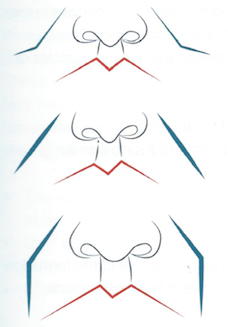Treating Nasolabial Folds
Nasolabial folds (NLFs) are creases from the wing of the nose to the corners of the mouth, separating the cheeks and the upper lip.
Noticeable NLFs are one of the first visual signs of ageing and a rather common concern for patients. NLFs usually hollow with age and can give the face a tired expression.

There are various types of NLFs comprising of convex, concave and straight.
Dr Ayham Al-Ayoubi notes that knowledge of the NLFs anatomy, facial fat distribution, and its deviations through ageing are fundamental for successful facial rejuvenation.
The distribution of the facial artery and its relation to the NLFs should be kept in mind when treating this area as well. Most of the time in aesthetic practice, NLFs are filled with dermal filler to reduce the depth of the line and deliver a more youthful look.
However, filling the NLFs to rejuvenate the lower face, without addressing the ageing midface with for example non-ablative radiofrequency, injection of botulinum toxin A, and threads can result in disharmony of the face as well as unsatisfactory results.
In addition to that the incorrect injection technique may worsen the appearance and prominence of NLFs and involuntarily change patient’s smile characteristics.
The development of the notable nasolabial fold is multifactorial. Ageing leads to continuous and selective ptosis of the cheek tissues with the comparatively modest change in the position of upper lip tissues.
The selective hypertrophy and ptosis of the cheek fat pads have a direct effect on the formation of NLFs.
A combination of the following factors can also contribute to a prominent NLF:
• Decreased skin density over the folds
• Surplus ptotic skin sidelong to the NLF
• Excessive fat deposits lateral to the folds that are fixed in place by holding ligaments
• Ptosis of the malar and sub-malar fat sections

The anatomic position of facial fat is a crucial factor in determining the facial shape. With ageing, there are qualitative and quantitative changes in facial fat.
A youthful face is full of well-supported fat with the intact support of retaining ligaments.
In the ageing face, facial fat descends and, therefore, the shape of the face changes.
Facial fat is highly compartmentalised, and the independent fat compartments are separated by vascularised boundaries.
Morphologic changes of these compartments play a significant role in ageing and the formation of NLFs.
Different fat compartments behave differently during the ageing process, and there is a general redistribution of fat with ageing.
With ageing, there is a minor migration of the fat compartments as well as volume shift within them.
Superficial fat compartments are the nasolabial fat, the medial cheek fat, the middle cheek fat, the lateral temporal cheek compartment, and three orbital compartments.
Deep mid-face fat compartments consist of the suborbicular oculi fat and the deep medial cheek fat.
The patient’s smile pattern and nasolabial fold in animation should be carefully analysed during treatment planning to prevent interference with facial expression.
Dr Ayham Al-Ayoubi explains: “The key to successful correction of NLFs and achieving patient satisfaction is a combination of correct diagnosis of what is causing the folds and careful patient selection.”
Knowledge of the age-dependent changes in the fat compartments results in natural volume redistribution and a more precise consumption of filler product with accurate application.
While the NLFs can be treated directly with dermal fillers, they simply add padding between the dermis of the lip and the superolateral border of the orbicular oris muscle resulting in softening of the fold.
However, it can likewise result in a medialisation (movement to the middle) of the fold, which can potentially worsen the appearance of the NLFs. An ideal treatment approach involves the elevation and suspension of the ptotic fat pads, with the support of the attenuated facial ligaments, and augmentation of lost volume.

Dr Ayham Al-Ayoubi adds: “The correction of the volume loss and ptosis should, therefore, be the primary aim of rejuvenation.”
This may involve the use of multiple treatment options, techniques and treatment sessions. The appearance of youth is directly correlated to contours, proportions and the quality of the soft tissues and skin. With a correct knowledge of anatomy, the ageing process, and changes, as well as product characteristics, practitioners can combine direct and indirect approaches to achieve a desirable aesthetic outcome.





